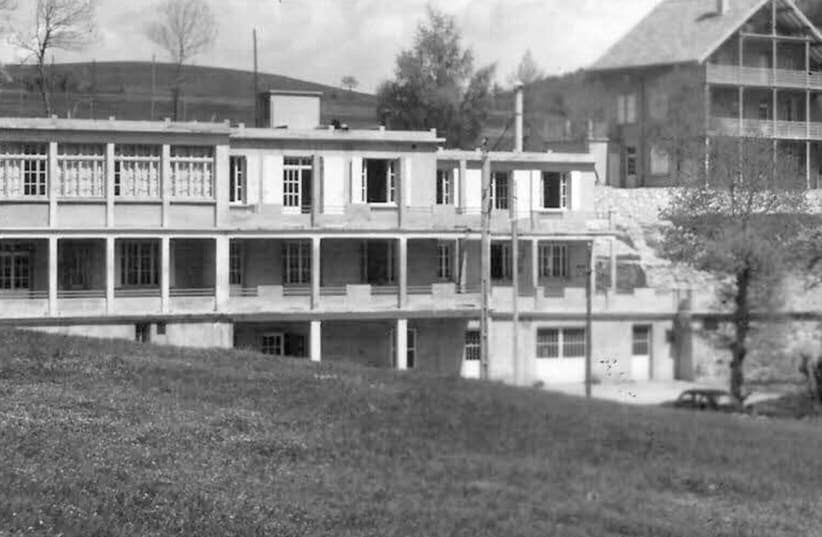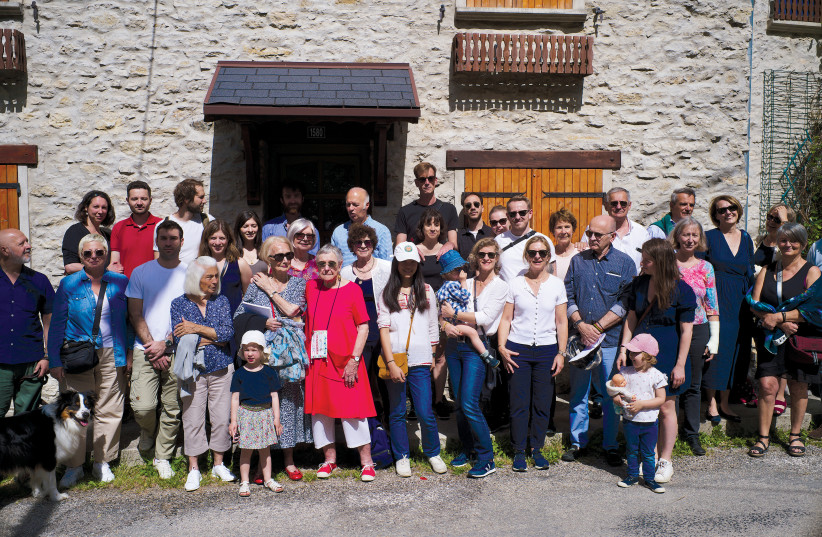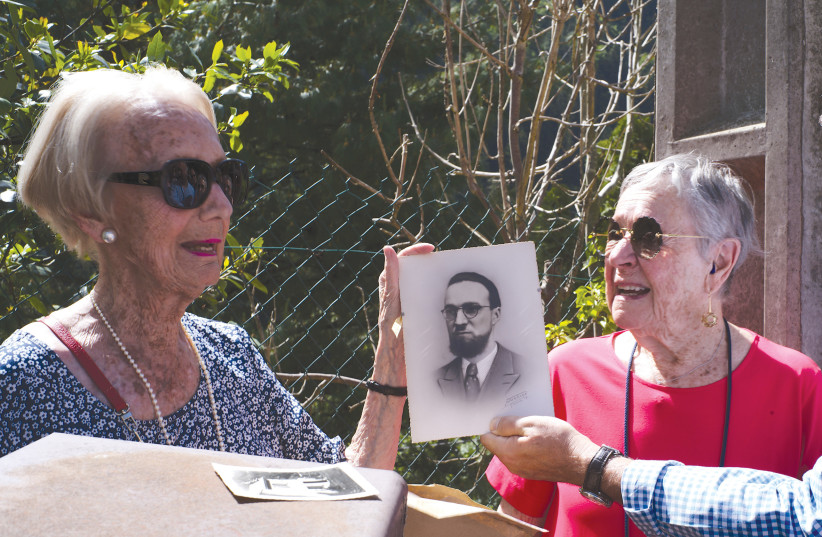In June 1944, in the tiny village of Engins near Grenoble in the south of France, a 14-year-old Jewish girl hiding with her family from the German army witnessed the arrest of a young man across the lane. As the girl watched, the neighbor, wearing a white shirt, was led away by the German patrol, finally disappearing at the turn of the road down the mountain. She understood somehow that he would never return.
Decades later, having become a well-known French painter living in Brussels, she suddenly realized something singular about her works of art: in each of her paintings there was always a splash or trace of white. She made the connection that it was a reflection of her subconscious memory of the man in a white shirt, and her premonition that he would not return.
That artist is my cousin Colette Bitker, today a vigorous 92. After the German occupation of France in 1940, she fled with her parents, brother and sister to Grenoble, then part of Vichy or “Free France” in the Rhône-Alpes region of southeastern France. When the German army occupied southern France in late 1942, after the Allied landing in North Africa, they managed to secretly rent a house in the remote hamlet of Engins in the Vercors mountains.
The family would stay in Engins for 18 months, simply taking on the identity of the local villagers. They followed the war’s progress via the BBC French service. Colette’s father, Henri, and brother, Michel, were active in the Maquis, the rural guerrilla bands of French Resistance fighters. Her mother, Mathilde, and sister, Nano, stayed in the house. The adults probably knew about the series of mass roundups of French Jews, though they wouldn’t have known their destination to Auschwitz.
This past June, 78 years later, Colette – the only one of the immediate family still alive – revisited Engins for an emotional reunion with the daughter of the man in the white shirt. Geneviėve Pannier, also 92, was the neighbor she used to play with.
In the event organized by Colette’s son Eric Kawan, 40 descendants and their families from France and Belgium came together to visit the village. Though I’m not a direct descendant, I am a Bitker, and so I flew from Israel to join the “cousinade” for what would prove an exceptional, treasured experience.
The story of Jews hiding in Nazi-occupied France in June 1944
June 1944 was only two months before the liberation of Grenoble, but war was still raging. Since the Allied landing in Normandy that month, the Germans were in a panic throughout France, especially targeting members of the French resistance that was particularly active in the Vercors region. Finding hidden Jews was an added bonus.
In her 2013 book Une chemise blanche dans le Vercors (“A white shirt in the Vercors”) illustrated with her watercolors, Colette poetically relates the story of the family’s stay in Engins: the intoxicating pastoral surroundings, and the German patrol that suddenly enters their house carrying out a quick search without discovering her brother hiding in the attic. The soldiers then crossed to the house across from theirs and arrested the young man who had just come on vacation from the city, who was wearing a white shirt.
As Geneviėve Pannier told our group gathered around her in Engins, her father, Vladimir Debellé, indeed never returned; he died on the train on the way to Dachau.
The tearful reunion between Colette and Geneviėve and her younger sister Chantal in front of the houses where they’d lived during the war became a moving local event, attended by the mayor and a journalist for the regional paper.
Geneviėve finally explained what happened to her father. Vladimir Debellé was an engineer who was neither a member of the Resistance nor a Jew. Originally Russian, he had a beard and wore heavy mountain shoes, which to the Germans apparently signaled an underground fighter. Together with two other men, he was lined up against the wall of the Bitkers’ house, hands on their heads, guns pointed at them.
“My whole family witnessed that macabre scene, waiting in terror for the death of our father. I have remained forever traumatized by that scene; till today, 78 years later, I can barely speak about it.”
Geneviėve Pannier
“My whole family witnessed that macabre scene, waiting in terror for the death of our father,” Geneviėve related. “I have remained forever traumatized by that scene; till today, 78 years later, I can barely speak about it.”
An officer gave the order to leave: Debellé wearing his white shirt was the last one to go, as Colette watched him taken away, “…this white glow in the darkness, a trace of life in the heart of the night,” she writes.
What the five-member Bitker family could not have known is that while they were hiding in plain sight in Engins, Colette’s future husband and his father were totally hidden just 50 kms to the south, in another tiny village in the Vercors region. Fifty years later that village, Prélenfrey-du-Gua, would be awarded the title of Righteous Among the Nations by Yad Vashem, the World Holocaust Memorial Center, for saving 51 Jews, including 20 children, during the war.
Among them were Eric’s father Boris (Bob) Kawan, then a teenager, and his father, Albert. Boris’s mother, Selma, was active in the National Front, an arm of the French resistance forces. The Kawan family had fled to southern France from Antwerp in 1940 after the German bombing of the city. They eventually found shelter with one of the families in Prélenfrey that was already hiding a Jewish child.
There were other French villages that sheltered Jews during the war. The most famous is Le Chambon-sur-Lignon, the Protestant village in south-central France that provided refuge to an estimated 5,000 people, including 3,500 Jews. (Several documentary films tell the story of Le Chambon-sur-Lignon.)
Prélenfrey’s extraordinary bravery, however, was only revealed in 1994 with the publication of The Conspiracy of the Righteous, a memoir by David Klugman.
The day after our June visit to Engens, our “cousinade” group visited the tiny postcard-perfect village of Prélenfrey, dwarfed by the massive ramparts of the Vercors mountains. The village had housed a clinic (the “preventorium”) for the treatment of youngsters at risk of tuberculosis, established and run by the local Guidi family before the war.
After the fall of France, the family kept on its Jewish children, taking in desperate newcomers after September 1943, when the Germans occupied the Grenoble area. Our guide, local resident Dominique Lardet, pointed out the imposing “preventorium” building, now long abandoned.
Adult Jews also sought refuge in the village, and were taken in by the residents in the surrounding farms. Many members of the French resistance also hid in the surrounding area and would come into the village for supplies. The Guidis’ acts, and those of the other families, placed them at great personal risk because the Germans were always searching for Resistance activists and Jews, and made frequent raids in the region.
In his autobiography, Bob Kawan described how the villagers “understood the need to establish a sentry on the road that led up to Prélenfrey from the valley, in order to warn of a possible approach of German troops. In May 1944, the Germans decided to put an end to the Vercors underground... and trucks filled with soldiers drove up to our village. The sentry succeeded in warning us in time... and we immediately left to hide in the forest at the bottom of the cliffs... The German soldiers searched methodically, going row by row through the bushes. Not far from me a man surrendered and was executed on the spot...”
In July 1944, only two months before the American army conquered the region and the German troops retreated, a German battalion entered Prélenfrey village looking for Resistance fighters and Jews. As our guide Dominique recounted, the Jewish children had fled to the mountains, responding to the pre-arranged warning signal from the postmistress in Grenoble. They were instructed not to come back down until they saw sheets hanging on the laundry lines in the village.
But in the village, the soldiers rounded up 32 men who were made to stand facing a wall in the village square, machine guns aimed at their backs. None of them revealed the presence of the Jewish children nor the weapon stashes in the village.
Suddenly Anne Wahl, the 19-year-old nurse at the Preventorium, came out and shouted at them to stop. These were not resisters, she said, they were simple peasants who knew nothing. The soldiers lowered their guns, deciding instead to take all the men to Gestapo headquarters in Grenoble for questioning.
Anne Wahl also saved the Jewish children still hiding in the sanatorium by convincing the soldiers that the ward contained the most contagious tuberculosis patients. “In general, the Germans were phobic when it came to contagious diseases, thus they avoided as much as possible checking the sanatorium,” Kawan noted in his autobiography. “This phobia helped save many Jewish children.”
After the German retreat from the region, Kawan joined the FTP armed resistance organization, taking part in the liberation of other parts of southern France.
In addition to the award to the village of Prélenfrey itself, in 1994 Yad Vashem recognized Anne Wahl and all the members of the Guidi family individually as Righteous Among the Nations. Photographs of the award ceremony with Israeli and French officials are on display in the center of the village.
During our tour, I asked Dominique how she explained that no one betrayed the villagers. “They may have been betrayed, at least once, though there was no proof,” she said. “But the people hiding there were all carrying out tasks for villagers, contributing to the local economy. Everyone knew, and,” she hinted, everyone would have been condemned.
In a 2012 French documentary (Cette Part D’humanité), Anne Wahl was asked how she explained the remarkably heroic behavior of the villagers. “It was natural,” she said simply. “I couldn’t have done otherwise. One must choose life.” ■


